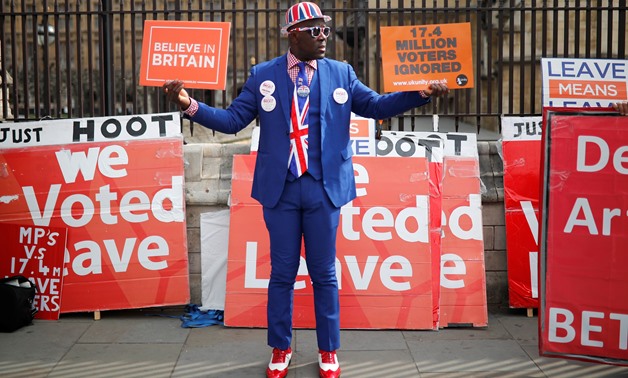
A pro-Brexit supporter holds placards outside the Houses of Parliament, following the Brexit votes the previous evening, in London, Britain, March 28, 2019. REUTERS/Alkis Konstantinidis
LONDON - 28 March 2019: British Prime Minister Theresa May hopes to bring her twice-defeated Brexit deal back to parliament for another vote. To get it through she will need to win over at least 75 lawmakers.
May's Conservatives do not have a majority in the 650-seat parliament, relying on Northern Ireland's Democratic Unionist Party's (DUP's) 10 lawmakers to prop up her government.
At the first vote, on Jan. 15, May's deal was rejected by 230 votes. At the second, on March 12, it lost by 149 votes.
On March 12, 75 of her Conservative Party lawmakers and all 10 DUP lawmakers voted against the deal. Seven non-Conservatives, including three opposition Labour Party lawmakers, voted for the deal.
DEAL THROUGH WITH ONLY CONSERVATIVE SWITCHERS?
May's party is deeply divided over the way forward.
When parliament voted on alternative Brexit options on Wednesday, 157 Conservatives voted in favour of leaving without a deal on April 12. Also, 93 of her lawmakers voted against the secondary legislation to delay the date of Brexit from March 29.
However, at least 20 Conservative lawmakers have indicated since March 12 that they would now support her deal, mainly due to fears the alternative could be a closer relationship with the European Union or not leaving at all.
British media have reported there are around 15 Conservatives who would never vote for May's deal, so even if she can persuade the other 60 to change their minds, she would still be 15 votes short.
WHAT ABOUT THE DUP?
Those Conservative hold outs could mean that even if May can win over the DUP lawmakers, who currently plan to vote against the deal, she would still need around five further votes.
In parliament's votes on Brexit options on Wednesday, just one DUP lawmaker, Jim Shannon, voted against a no-deal exit. The others abstained.
EVERYTHING RESTS ON LABOUR REBELS?
If May does not convince the DUP, she would need at least 15 Labour lawmakers who voted against the deal last time to swing behind it. In reality the number is likely to be higher as some of the 60 or so Conservatives who could still be persuaded to back the deal may only do so if the DUP supports it.
There is still some hope for May. At Wednesday's votes on Brexit options, 27 Labour lawmakers rebelled against their party's position by voting against holding a confirmatory public vote on any Brexit deal and a further 18 abstained.
Four Labour lawmakers voted against the party's own Brexit plan and seven abstained.
May's statement last week, in which she blamed parliament for the Brexit delay, angered some Labour lawmakers who had appeared to be moving towards backing the deal.
While her promise on Wednesday to step down if the deal passes may have helped win over some in her Conservative Party, it is likely to have damaged the chances of gaining the support of Labour lawmakers who do not like some of her possible successors.

Comments
Leave a Comment